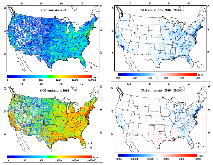Exploiting OMI NO2 satellite observations to infer fossil-fuel CO2 emissions from U.S. megacities
- Argonne National Lab. (ANL), Lemont, IL (United States); Univ. of Chicago, IL (United States)
- Univ. Space Research Assoc., Columbia, MD (United States); NASA Goddard Space Flight Center (GSFC), Greenbelt, MD (United States)
- Environment and Climate Change Canada, Toronto, ON (Canada)
- NASA Goddard Space Flight Center (GSFC), Greenbelt, MD (United States)
Fossil-fuel CO2 emissions and their trends in eight U.S. megacities during 2006–2017 are inferred by combining satellite-derived NOX emissions with bottom-up city-specific NOX-to-CO2 emission ratios. A statistical model is fit to a collection NO2 plumes observed from the Ozone Monitoring Instrument (OMI), and is used to calculate top-down NOX emissions. Decreases in OMI-derived NOX emissions are observed across the eight cities from 2006 to 2017 (-17% in Miami to -58% in Los Angeles), and are generally consistent with long-term trends of bottom-up inventories (-25% in Miami to -49% in Los Angeles), but there are some interannual discrepancies. City-specific NOX-to-CO2 emission ratios, used to calculate inferred CO2, are estimated through annual bottom-up inventories of NOX and CO2 emissions disaggregated to 1 × 1 km2 resolution. Over the study period, NOX-to-CO2 emission ratios have decreased by ~40% nationwide (-24% to -51% for our studied cities), which is attributed to a faster reduction in NOX when compared to CO2 due to policy regulations and fuel type shifts. Combining top-down NOX emissions and bottom-up NOX-to-CO2 emission ratios, annual fossil-fuel CO2 emissions are derived. Inferred OMI-based top-down CO2 emissions trends vary between +7% in Dallas to -31% in Phoenix. For 2017, we report annual fossil-fuel CO2 emissions to be: Los Angeles 113 ± 49 Tg/yr; New York City 144 ± 62 Tg/yr; and Chicago 55 ± 24 Tg/yr. A study in the Los Angeles area, using independent methods, reported a 2013–2016 average CO2 emissions rate of 104 Tg/yr and 120 Tg/yr, which suggests that the CO2 emissions from our method are in good agreement with other studies' top-down estimates. Lastly, we anticipate future remote sensing instruments – with better spatial and temporal resolution – will better constrain the NOX-to-CO2 ratio and reduce the uncertainty in our method.
- Research Organization:
- Argonne National Lab. (ANL), Argonne, IL (United States)
- Sponsoring Organization:
- USDOE Office of Fossil Energy (FE); USDOE Office of Science (SC)
- Grant/Contract Number:
- AC02-06CH11357
- OSTI ID:
- 1569244
- Alternate ID(s):
- OSTI ID: 1556999
- Journal Information:
- Science of the Total Environment, Vol. 695, Issue C; ISSN 0048-9697
- Publisher:
- ElsevierCopyright Statement
- Country of Publication:
- United States
- Language:
- English
Web of Science
A methodology to constrain carbon dioxide emissions from coal-fired power plants using satellite observations of co-emitted nitrogen dioxide
|
journal | January 2020 |
Similar Records
Fossil fuel CO2 emissions over metropolitan areas from space: A multi-model analysis of OCO-2 data over Lahore, Pakistan
A methodology to constrain carbon dioxide emissions from coal-fired power plants using satellite observations of co-emitted nitrogen dioxide







